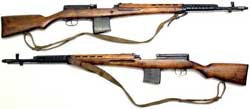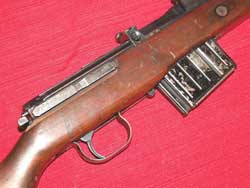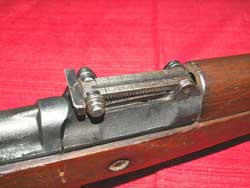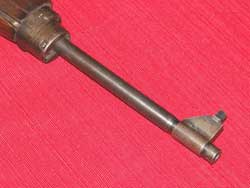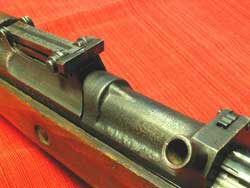| Remington Brand | Browning Brand | Winchester Brand | Mauser Gun |
Mauser Gewehr 43 Semi - Automatic RifleCharacteristics:Type: Automatic Rifle. Caliber(s): 7.92x57 mm Weight unloaded: 4.33 kg. Barrel length: 1015 mm. Magazine capacity: 10 rounds.
Info Mauser Gewehr 43 Semi - Automatic RifleBefore the start of the 2nd World War, German army had little interest in self-loafing rifles. Their tactical doctrine centered around infantry squad with MG.34 universal machine gun as primary source of firepower, supported by the riflemen with Kar.98K bolt-action rifles. By the 1941, two companies submitted the self-loading rifles for consideration of German Army - Walther and Mauser. These rifles were designates as Gewehr 41(W) and Gewehr 41(M), respectively, or G41(W) and G41(M), in short. Both rifles were somewhat similar in that they were gas-operated self-loaders, both utilizing the Bang-type annual gas pistons, located at the muzzle of the gun, within the relatively large muzzle cap. Both were fed from fixed 10-round magazines. Both rifles were tested in combat and both proved as poor performers. The Bang-type muzzle gas system was among the key sources of the problems, so, by the late 1943 Walther engineers mated the G41(W) action with the much more effective and reliable gas system of the Ru ssian Tokarev SVT-40 rifle. The resulting design was designated as Gewehr 43, or Gew.43, or G43 in short. In the 1944 the Gew.43 was re-designated as Kar.43 (Karabiner 43, K43), with no visible changes made, and under this designation it was manufactured until the end of the war. Kar.43, made in relatively large numbers, was issued mostly as a specialist's weapon, often fitted with optical telescope sight. Like many other weapons, made during late stages of the war, the Kar.43 showed little attention to the finish in all areas, where finish was insignificant for functional needs. There were several experimental developments on the basis of Kar.43, including selective fire versions, as well as versions chambered for 7.92x33 Kurtz ammunition and adapted for Stg.44 magazines. Neither version entered production. During the early post-war period, Czechoslovak army used some Kar.43 rifles as sniper weapons. The Gew.43 / Kar.43 is a gas operated, semi-automatic weapon. The short stroke gas piston is located above the barrel. The bolt is locked by two flaps, which extend into the locking recesses in the receiver walls. When unlocking, these flaps are retracted into the bolt body. The receiver and bolt groups are machined from steel castings, with many surfaces being mechanically unfinished. Lots of stampings also are used throughout the construction. The rifle is fed from detachable box magazines, which held 10 rounds. Each G.43/K.43 rifle had the dovetail, which can accept the telescope sight mount, in addition to the standard adjustable open sights. |
MAUSER HISTORI MAUSER PISTOLS
MAUSER RIFLES
BIB.GE Categories |


